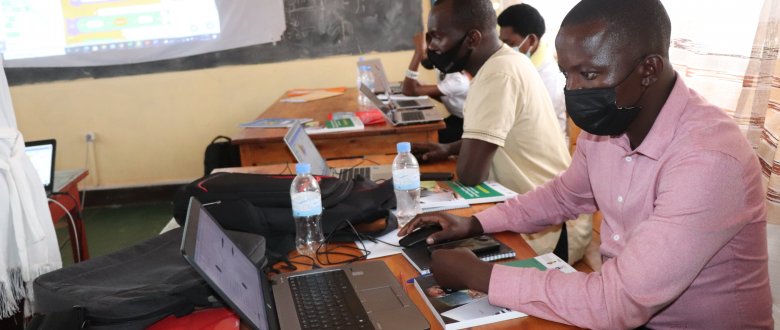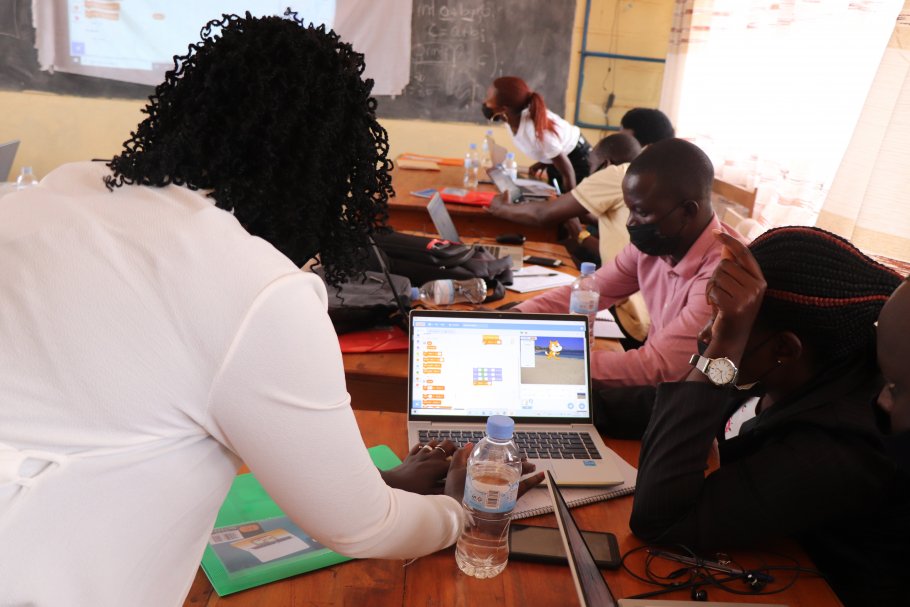
In October 2020, VVOB launched the Scratc²h 2050 project supported by Enabel’s Wehubit programme, to improve the relevance of secondary STEM education and strengthen the link with the world of work by supporting STEM and ICT teachers to set up after-school coding clubs.
Emmanuel Ndabacahe, 35, is one of the teachers from 52 secondary schools in Kayonza district, Eastern Province, where the project was implemented untill June 2022. He participated in the Scratc²h learning trajectory that focussed on competencies to integrate Scratch, a programming language, in STEM and ICT lesson plans and to initiate after-school Scratch coding clubs in their schools.
A mathematics teacher for nine years, Mr Ndabacahe currently teaches at New Life Christian Academy in Kayonza district. He studied applied mathematics at university. He was already trying to explain the application of maths to real-life situations to his learners, but he found Scratch as a great tool that will help to boost learners’ interest and creativity in science subjects such as mathematics.
Missing link
When Nbabacahe was in secondary school, he could not see the relevance of maths in everyday life. “Back in my day, our mathematics teacher could not link science with real life. We were just memorising formulas, but no one could easily tell how mathematics would be applied in real-life situations. I started understanding the application of mathematics in real-life at university,” he said.
Mr Ndabacahe believes that integrating Scratch in mathematics will make his work as a teacher much easier. “I am very excited that I learnt Scratch. It is an important tool that will help learners to practice their ideas and creation based on what they learn. It will certainly help me to link mathematics content with real-life situations, so learners will understand well its application in everyday life.”
“I can apply Scratch to basic mathematical operations such as addition, subtraction, multiplication in a more concrete way. Also, when you teach similar right triangles to students, or any other geometrical figure, you can draw them in Scratch and animate or turn them so that students can easily understand. You can also use Scratch to show the application of similar right triangles in real life. For instance, you can show how to use similar right triangles with trigonometry to indirectly measure heights of tall subjects such as trees, buildings….” Mr Ndabacahe said.
Mr Ndabacahe also realised that Scratch is a practical and useful tool in teaching logical mathematics “For instance, it may be difficult for a learner to understand whether a statement like ‘5 is greater than 3; and 2 is greater than 7’ is true or false. But when you use coding a learner can clearly see the answer.”
Boosting learners’ critical thinking
“Coding can boost critical thinking among learners and promotes solution-driven mindsets. If you show a learner how to create a story or a game with Scratch, and they get stuck at some point, they will explore, think and discover even more. Coding improves learners’ creativity and problem-solving skills. A learner would think that ‘If I solved this, I can also solve other challenges.”
Mr Ndabacahe believes that with Scratch, learners’ performance will also increase. “You cannot do well in a subject you do not like, but liking a subject implies making effort to understand it and perform well in it.”
Mr Ndabacahe together with his three colleagues with whom they attended the Scratc²h trainings, set up four groups of coding clubs at his school soon. He believes that coding clubs will lay a strong foundation among learners as far as coding and loving science subjects is concerned. “When students learn coding at young age, they adapt to new technology and become more creative in problem-solving”.

Visit our resource library of materials developed during the Scratc²h 2050 project implementation. These materials are designed for secondary school teachers and learners in Rwanda and consist of:
- a pedagogical guide
- instructional videos
- lesson plans
- unplugged coding activities




